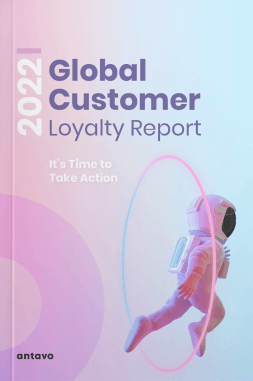
We are seeing a digital transition and the emergence of a new customer reality in the post-pandemic era. All of this has had a significant effect on loyalty, customer retention, and marketing. Loyalty programmes are being introduced or updated across a wide range of industries, including agricultural, automotive, fashion, transportation, and more, as businesses increasingly recognise the value of retaining and engaging customers. We’ve compiled the most pertinent brand loyalty data from our Global Customer Loyalty Report 2022 to assist you understand the evolving landscape of loyalty programmes.
What You Should Know About the Report
The Global Customer Loyalty Report 2022 from Antavo offers a thorough examination of the loyalty market’s present and future conditions as seen by businesses and loyalty experts. It includes perception offered by:
More than 320 corporate survey participants from all around the world Information gathered from over 25 million member behaviours monitored by Antavo’s Loyalty Management system
Trends in global loyalty, including those in North America, Europe, Asia, and the Middle East
Experts on loyalty offer more viewpoints
interviews with reputable businessmen and women
Consider it as your own action plan with brand loyalty data that will enable you to assess your goals against the current loyalty landscape and identify the trends and techniques for loyalty programmes that will influence how customers behave.
The Situation with Loyalty Programs Right Now
Loyalty programmes have evolved into industry norms in every sector, including banking, fashion, and even travel. But how do companies that already have a loyalty programme assess the effectiveness of it? What are the program’s current obstacles and driving forces? Resulting from the report’s findings:
While 42.3% of respondents reported neutral satisfaction with their loyalty programme, 56.0% of programme owners expressed satisfaction or extreme satisfaction with it.
Just 1.7% of respondents expressed direct dissatisfaction with their current programme.
The majority of respondents, 71.6%, stated that they are “likely” or “very likely” to overhaul their loyalty programme when asked whether they would like to do so.
The main driving force for running a loyalty programme for both existing and upcoming programme owners has been boosting client involvement.
Since Covid-19, the ability to provide seamless multichannel experiences has been the biggest hurdle for loyalty programme owners.
You can find more loyalty statistics about the current state of loyalty programmes, an in-depth comparison of the top five challenges facing both current and upcoming loyalty programmes, as well as an analysis of the relationship between high satisfaction levels and the desire to revamp a loyalty programme.
Loyalty Initiatives During a Crisis
There have been other crises that businesses have had to deal with besides the Covid-19 pandemic. Online privacy regulations and the phase-out of third-party cookies have recently compelled businesses to rethink their data strategy and look for alternative ways to gather customer data. According to the report’s brand loyalty statistics, loyalty programmes have been extremely helpful in both circumstances:
60.5% of those polled claimed to have improved or greatly increased their efforts to develop their loyalty strategy during the pandemic.
62.1% of businesses claimed that their loyalty programme had kept customers interested throughout the COVID-19 problem.
Through Covid-19, participants in higher tier levels saw a visit frequency that was 29.6% higher than those in lower tiers.
Companies with tiers in their loyalty programmes reported a 1.8X better return on investment than those without them.
Customer loyalty and loyalty marketing have a significant influence on their company’s overall strategic decisions, according to 66.4% of respondents.
Industry Trailblazers of Today
All participants were asked to identify the loyalty programme trends or programme aspects they thought will significantly grow or become more effective over the next three years in order to gain an accurate view of how the loyalty market will look in the near future.
In descending order of votes, respondents said the following loyalty schemes were the most motivating:
Starbucks Amazon Nike PC Optimum Sephora
In order to help you leverage the lessons learned for your own loyalty concept, we’ve provided a thorough analysis of each of these loyalty programmes in our study, along with a look at why they’re so inspirational.
The future of loyalty is emotional
Given that so many current programme owners intend to update their offerings, it begs the question of what fashions they will adopt.
Right now, the majority of loyalty programmes use the transactional approach. Intriguingly, the bulk of programmes now in the development stage appear to be emphasising emotional involvement and experience incentives more:
Only 20.7% of those who responded and offered a loyalty programme identified theirs as being more irrational than reasonable.
53.6% of those designing a loyalty programme indicated that it will emphasise emotion over reason.
65.2% of those who do not already offer experiential rewards said they intend to do so within the next three years.
55.4% of businesses preparing loyalty programmes said their schemes will include experiential benefits.
There will be a global increase in the usage of experiential rewards, especially for early access perks, which are anticipated to increase by 26.7%.
40.5% of programme owners said they use personalised incentives or offers in some way.
Download our paper to learn more about the types of incentives that make up an emotional programme and the statistics on the acceptance rate of customised awards. Additionally, it provides information on brand loyalty and insight into personalised rewards.
The moment is here to take action!
What members of loyalty programmes now regard as “the default” will no longer be the case in three years. Companies need to move swiftly and cautiously while keeping an eye on which trends are gaining traction if they want to enter the loyalty industry soon or redesign existing programme.
Are you prepared to tackle the future of your loyalty programme? At Antavo, our specialists are more than willing to assist. Send us an RFP or schedule a demo to see what our technology can do.
